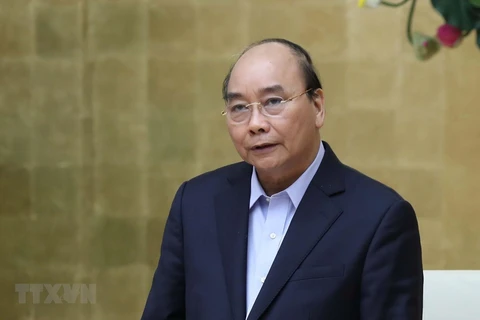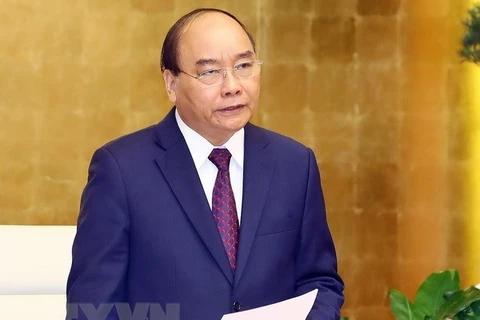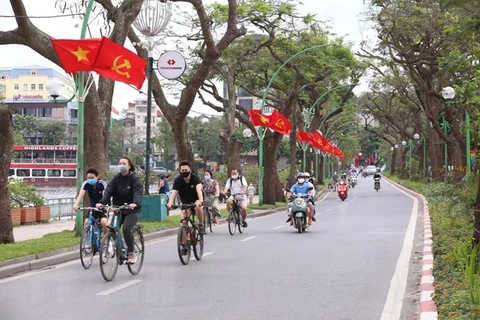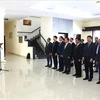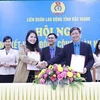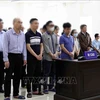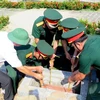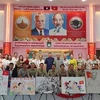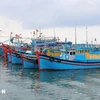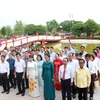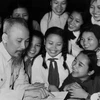Hanoi (VNA) - Non-essential services like clothes and cosmetics shops have been barred from opening earlier than 9am in Hanoi to reduce morning traffic density, Chairman of the municipal People’s Committee Nguyen Duc Chung said on April 29.
Malls and supermarkets located in the inner city and new urban areas, except for restaurants, pharmacies, petrol stations, food stores in the market, will not be allowed to open early, in order to reduce contacts and the risks of congestion.
Hanoi eased social distancing policies on April 23, allowing restaurants, cafes, clothes and cosmetics shops to reopen but customers have to keep their distance from each other.
Religious gatherings, celebrations and all sporting and cultural activities are still banned. Bars, karaoke venues and massage parlours will remain shut.
At a meeting of the city’s steering committee for COVID-19 prevention and control this week, Chung said according to a study conducted by experts, the most worrying problem in the capital city is high traffic density in the morning.
When people stop at traffic lights, the requirement of keeping a minimum distance (one metre) between vehicles might not be easy to follow, he said.
“Revenues of non-essential service shops from 6am to 8.30am are very low. The city does not encourage business owners to open their shops during this time,” he said.
On April 28, Chung ordered restaurants and coffee shops which pose direct infection risks to keep a minimum distance of 2m between customers or 1m with plastic divides. Customers are advised not to share bowls, cups and other items while eating and drinking.
Restaurant and shop owners have been encouraged to sell takeaway food and drinks.
Factories and construction sites are allowed to resume operation but must take necessary hygiene measures for their workers and employees.
Inter-provincial coaches are allowed to run as long as drivers and passengers follow preventive measures.
The city’s authorities also decided to reopen universities, colleges, vocational training schools, secondary and high schools from May 4, while primary grade students and lower will be returning from May 11.
Schools will have to reduce the number of students in a classroom and avoid big gatherings during meal and break times.
Chung said the pandemic might last long although the country has not recorded new cases in recent days.
He asked local authorities at district and ward levels, clinics and hospitals to offer training to medical workers and COVID-19 quick response teams for taking testing samples and tracking patients’ travel history.
The city’s health care sector needs to improve its capacity to be able to conduct 3,000 to 5,000 RT-PCR tests daily, he said.
The city can currently test between 2,500 and under 3,000 a day.
According to Director of the Hanoi Department of Health Nguyen Khac Hien, the city has not recorded any new cases since April 15. Eighty-five out of 112 patients in the city have recovered.
However, Hanoi is still prone to risks because flights carrying Vietnamese from overseas will arrive in the city in the coming days.
The department urged the public to stay vigilant with preventive measures while the health care sector will continue to curb transmission from foreign sources by quarantining people from overseas and prevent the virus from being transmitted in the community.
Chung emphasised that people must strictly follow preventive measures like wearing masks, washing hands and keeping their distance.
“These measures are not for the short term but must be followed in the long term,” he said.
Chung asked departments and agencies in the capital to maintain the spirit of “fighting the pandemic as if fighting an enemy” and called for the involvement of the entire political system and all people in the fight.
Hanoi will maintain the principles of prevention, detection, quarantine, sealing off epidemic clusters, treatment, and minimising fatalities, he said, stressing that it will remain vigilant against the outbreak.
Me Linh and Thuong Tin districts, two among the few localities nationwide still classified in the high-risk group due to recent outbreaks, will need to continue following instructions until risk levels are reviewed and revised, he said./.
Malls and supermarkets located in the inner city and new urban areas, except for restaurants, pharmacies, petrol stations, food stores in the market, will not be allowed to open early, in order to reduce contacts and the risks of congestion.
Hanoi eased social distancing policies on April 23, allowing restaurants, cafes, clothes and cosmetics shops to reopen but customers have to keep their distance from each other.
Religious gatherings, celebrations and all sporting and cultural activities are still banned. Bars, karaoke venues and massage parlours will remain shut.
At a meeting of the city’s steering committee for COVID-19 prevention and control this week, Chung said according to a study conducted by experts, the most worrying problem in the capital city is high traffic density in the morning.
When people stop at traffic lights, the requirement of keeping a minimum distance (one metre) between vehicles might not be easy to follow, he said.
“Revenues of non-essential service shops from 6am to 8.30am are very low. The city does not encourage business owners to open their shops during this time,” he said.
On April 28, Chung ordered restaurants and coffee shops which pose direct infection risks to keep a minimum distance of 2m between customers or 1m with plastic divides. Customers are advised not to share bowls, cups and other items while eating and drinking.
Restaurant and shop owners have been encouraged to sell takeaway food and drinks.
Factories and construction sites are allowed to resume operation but must take necessary hygiene measures for their workers and employees.
Inter-provincial coaches are allowed to run as long as drivers and passengers follow preventive measures.
The city’s authorities also decided to reopen universities, colleges, vocational training schools, secondary and high schools from May 4, while primary grade students and lower will be returning from May 11.
Schools will have to reduce the number of students in a classroom and avoid big gatherings during meal and break times.
Chung said the pandemic might last long although the country has not recorded new cases in recent days.
He asked local authorities at district and ward levels, clinics and hospitals to offer training to medical workers and COVID-19 quick response teams for taking testing samples and tracking patients’ travel history.
The city’s health care sector needs to improve its capacity to be able to conduct 3,000 to 5,000 RT-PCR tests daily, he said.
The city can currently test between 2,500 and under 3,000 a day.
According to Director of the Hanoi Department of Health Nguyen Khac Hien, the city has not recorded any new cases since April 15. Eighty-five out of 112 patients in the city have recovered.
However, Hanoi is still prone to risks because flights carrying Vietnamese from overseas will arrive in the city in the coming days.
The department urged the public to stay vigilant with preventive measures while the health care sector will continue to curb transmission from foreign sources by quarantining people from overseas and prevent the virus from being transmitted in the community.
Chung emphasised that people must strictly follow preventive measures like wearing masks, washing hands and keeping their distance.
“These measures are not for the short term but must be followed in the long term,” he said.
Chung asked departments and agencies in the capital to maintain the spirit of “fighting the pandemic as if fighting an enemy” and called for the involvement of the entire political system and all people in the fight.
Hanoi will maintain the principles of prevention, detection, quarantine, sealing off epidemic clusters, treatment, and minimising fatalities, he said, stressing that it will remain vigilant against the outbreak.
Me Linh and Thuong Tin districts, two among the few localities nationwide still classified in the high-risk group due to recent outbreaks, will need to continue following instructions until risk levels are reviewed and revised, he said./.
VNA

